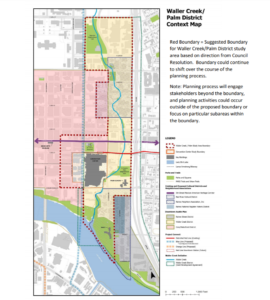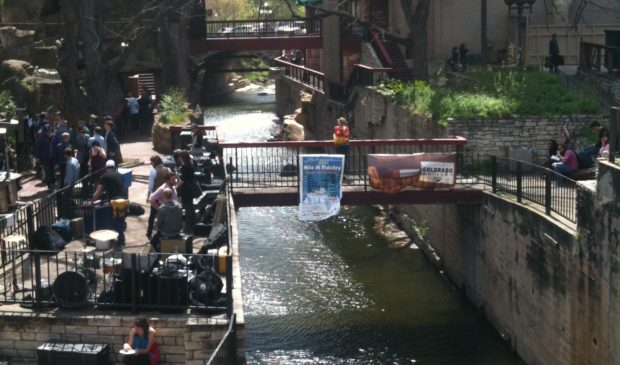Memo suggests expanding Palm School plan to include Waller Creek, medical district
Tuesday, October 15, 2019 by
Chad Swiatecki The city’s Planning and Zoning Department has recommended greatly expanding the scope of revitalization plans focused around the Palm School property, to include the entirety of the Waterloo Greenway project and more of the downtown core.
The change suggested would include substantially more property, and several existing planning areas, than what was included in a May vote by City Council that sought to preserve the historic school property and endorsed an aggressive expansion of the Austin Convention Center.
A memo released last week by Jerry Rusthoven, assistant director of Planning and Zoning, laid out the suggested new work program that would run through spring 2021.
The memo is short on specific reasons for expanding the planning area, other than saying existing analysis and input from stakeholders led to the push, and that it is possible some synergies exist between projects in neighboring areas.
It reads in part: “The study area will be evaluated to identify opportunities for coordination across initiatives and to identify potential areas of conflict. Recommendations will be designed to enhance existing plans and to maximize synergies among the various initiatives and components of the Waller Creek/Palm District.”

Map of the proposed changes
Council’s vote in May was based around creating a Palm District Master Plan and a district that would emphasize the area’s Mexican American cultural heritage. That goal is still in effect with the proposed expansion, which would include the Red River Cultural District, the Downtown Station, the innovation district around Dell Medical School, and portions of Waterloo Greenway and the Fifth Street Mexican American Heritage Corridor.
The end result of the planning process would be amendments to the city’s downtown plan, the Waller Creek District Master Plan and the city’s Land Development Code. It would be paid for using budgets from a consortium of city departments involved in downtown planning, with no additional staff expected to be needed.
Council Member Kathie Tovo, whose district includes much of downtown Austin, said she has reviewed the memo, but hasn’t spoken with Planning and Zoning staff about the rationale behind their wish to expand the planning area. She said the city’s priority for the Palm School area should be on preserving and restoring the Palm School building and taking other steps to enhance the sense of cultural heritage there and in surrounding portions of downtown.
“When we passed this I didn’t anticipate expanding the area of focus, and I want to make sure that we resolve the challenges that are specific to the areas around the Palm School,” she said. “There has already been some pretty comprehensive planning and thinking around areas like the innovation zone, but maybe not in a way that is relative to other projects that are happening in the area.”
Tovo said other priorities for the area around the Palm School and Austin Convention Center include creating more inviting public spaces and improving mobility for pedestrians and other non-vehicular uses.
An ordinance set for consideration at this week’s Council meeting could create placemaking improvements for the Rainey Street area by renewing funding for the Rainey Street Historic District. That district was organized in 2014 but was given just one year of funding from rights-of-way fees and other license agreements.
Before taking any action to adopt the new work plan, Tovo said she plans to consult with planning staff to learn more about the motivation to expand the district.
“I need to start by having a conversation with the planning staff on the intent and the reasons behind what they are suggesting, to make sure there’s still a priority placed on the area around the school,” she said. “There’s good things that could be done in those other places, and I do want things to connect to what’s happening to the north, but I also don’t want our work to get diluted.”
Photo by William Beutler made available through a Creative Commons license; map courtesy of the city of Austin.
The Austin Monitor’s work is made possible by donations from the community. Though our reporting covers donors from time to time, we are careful to keep business and editorial efforts separate while maintaining transparency. A complete list of donors is available here, and our code of ethics is explained here.
You're a community leader
And we’re honored you look to us for serious, in-depth news. You know a strong community needs local and dedicated watchdog reporting. We’re here for you and that won’t change. Now will you take the powerful next step and support our nonprofit news organization?










